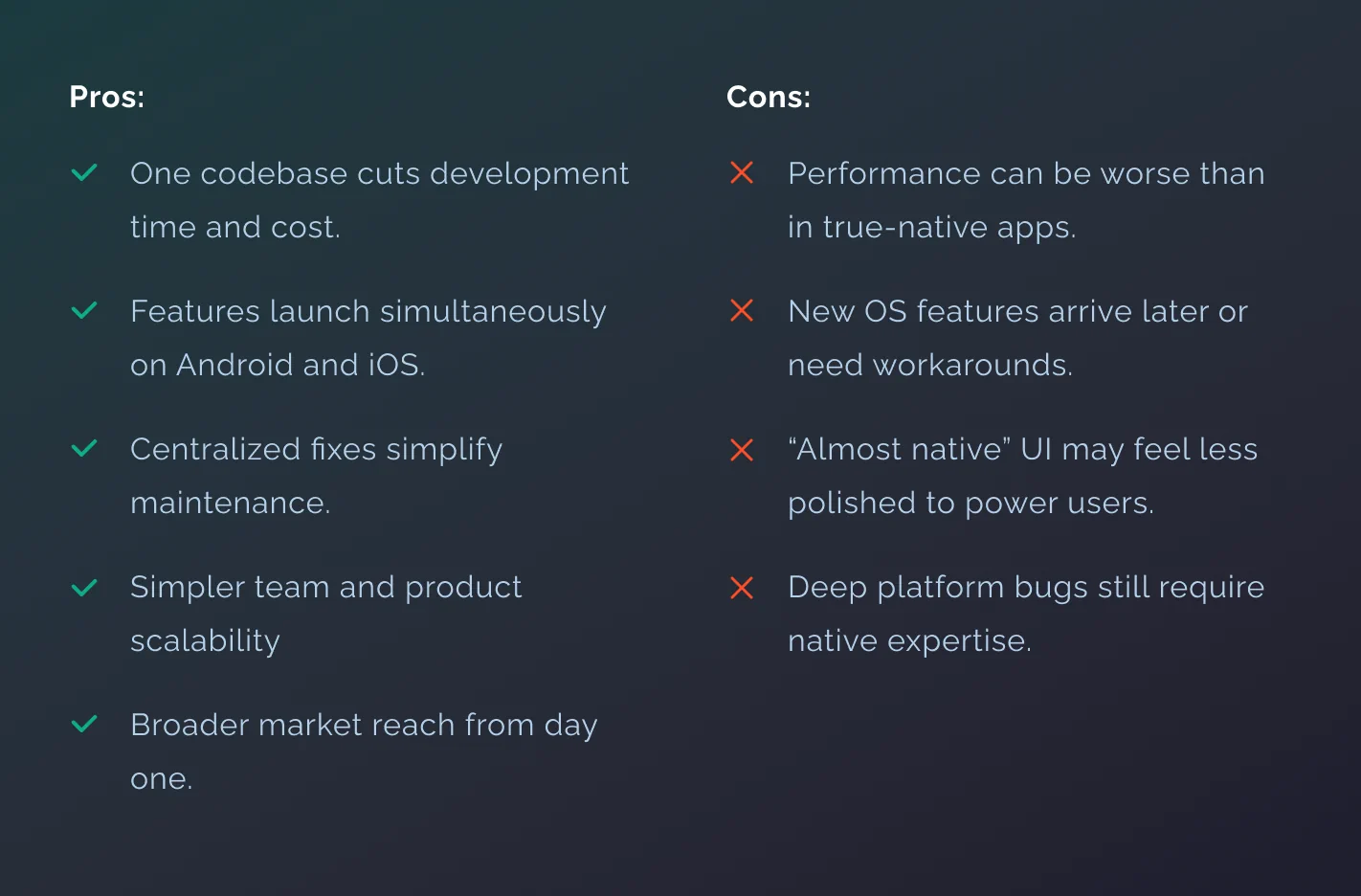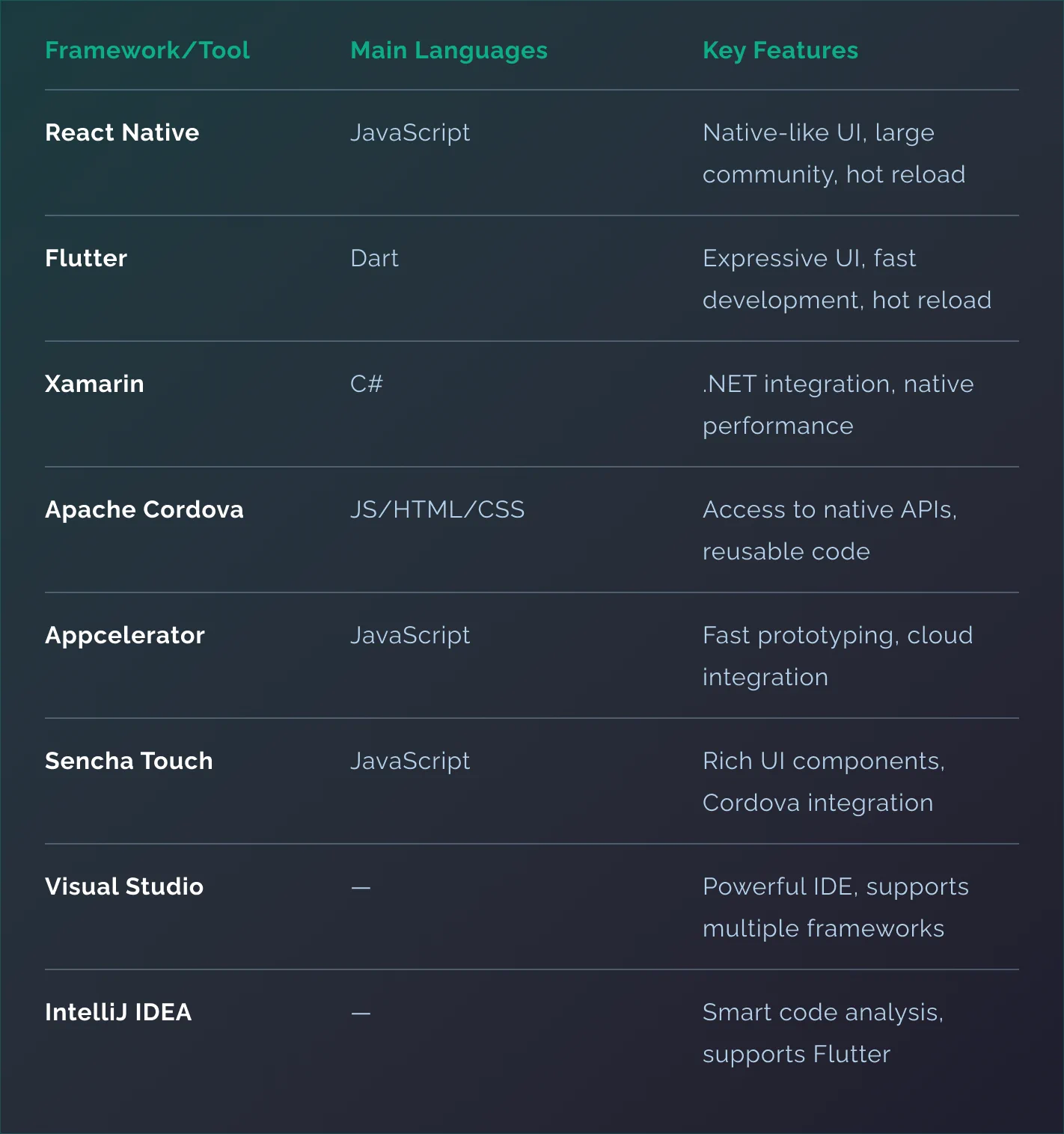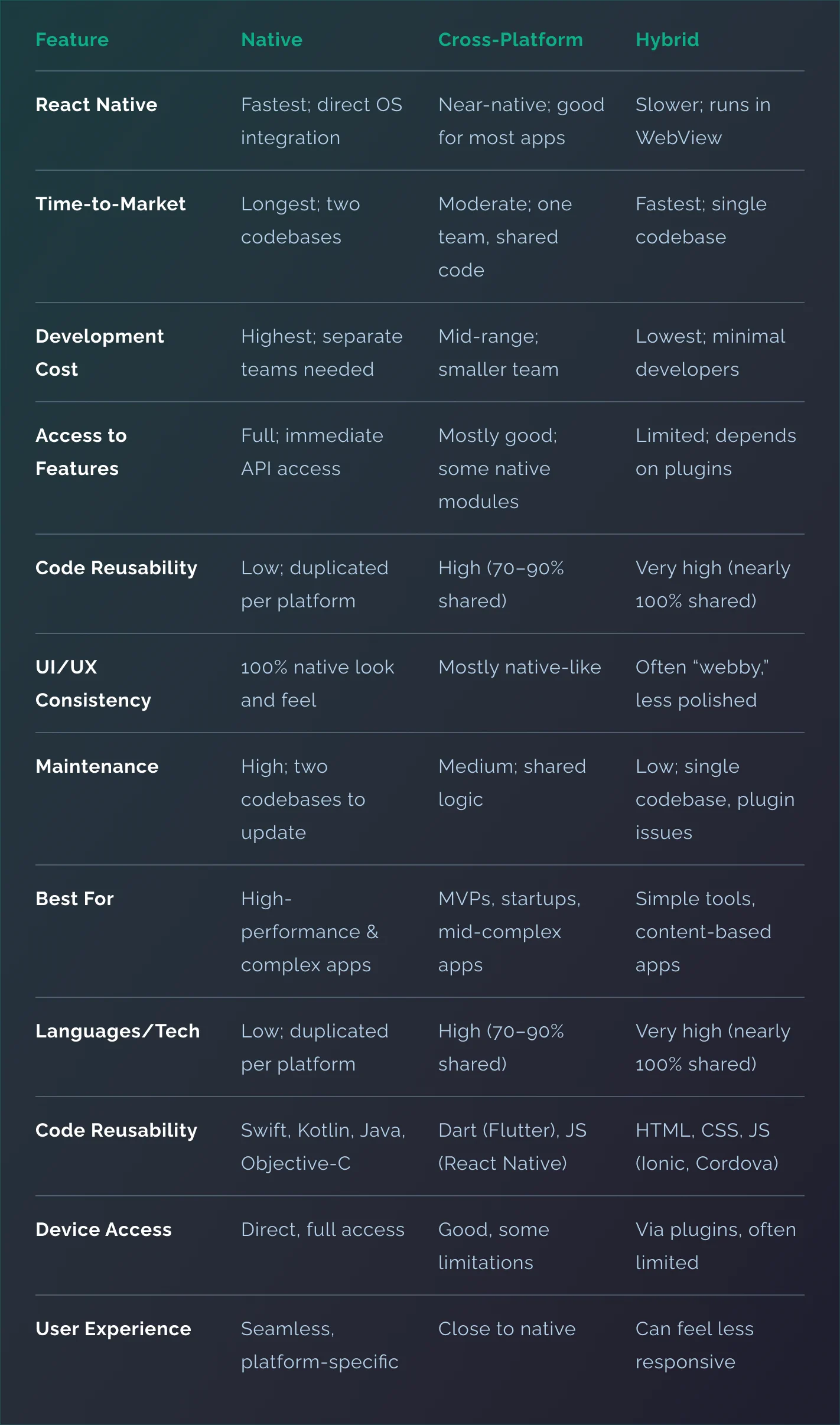Cross-Platform Mobile App Development Guide: Key Benefits, Technologies, and Use Cases

Mobile screens are accountable for 63.5% of global website traffic, making them a must-have solution for modern business. As budgets tighten and release cycles accelerate, cross-platform mobile app development has emerged as the shortest path to put the same product in every user’s pocket. If you plan to cover both Android and iOS users, this is your best engineering approach.
In this article, you’ll learn about cross-platform mobile application development, along with its benefits and use cases. This guide is based on Implex’s over 5 years of industry expertise and the current market trends.
What is Cross-Platform App Development?
Cross-platform mobile development is the practice of writing one codebase that compiles fully featured apps for multiple operating systems. Instead of maintaining two (or more) separate native projects, developers share up to 95% of the codebase across targets.

Pros and Cons
It’s important to understand that there isn’t a one-size-fits-all approach. While you’ll gain certain advantages by using cross-platform development, they’ll also come with several drawbacks.

Implex’s mobile app development services can help you get all the benefits while mitigating the cons, providing high-performance software that dominates the market.
How It Differs From Native Development
The approach to cross-platform software development is different across three key elements:
- Language & tooling. Native stacks require you to master Swift/Objective-C, as well as Kotlin/Java. Cross-platform stacks conceal OS APIs behind a unified framework, such as Flutter and React Native.
- Compilation pipeline. Native apps compile to platform-specific binaries. Cross-platform tools translate the shared multiplatform code into those binaries for you.
- Team structure. Native demands two dedicated teams, whereas cross-platform allows a single developer team to own both workflows.
This dramatically shrinks cost and maintenance overhead, allowing your team to focus budgets on marketing rather than extra development.
How Cross-Platform Development Works

Let’s take a closer look at the core elements of cross-platform development for iOS and Android.
Shared Codebase
Every multiplatform app development project has a directory with business logic, UI components, tests, and other components. This logic is only written once and can be reused up to 90% across all relevant platforms. When the team fixes a bug or adds a feature, they do it in one place, and both apps get the update. Development hours are reduced, and so are your expenses.
Role of Frameworks and Tools
You can only work with cross-platform application development using a certain set of frameworks and technologies, as not all of them are suited for this approach. If you choose the right tools, you’ll get the following benefits in your project:
- Code reusability. Frameworks like React Native, Flutter, and Xamarin allow developers to write code once and deploy it across various platforms.
- Faster development. As you use pre-built & reusable components and libraries, you’ll get a shorter development process that accelerates your time-to-market.
- Cost-efficiency. Developing a single app for multiple platforms significantly reduces development costs, as fewer resources and smaller teams are required.
- Same user experience. Frameworks offer UI components that adapt to each platform’s design language, ensuring a cohesive and native-like user experience across all devices.
This makes mobile cross-platform development an attractive choice for startups and companies with limited budgets. You’ll be able to cover both Android and iOS markets at the same costs. Later, when you acquire a larger budget, you can switch to a native app if it seems necessary.
Compilation and Deployment Process
Cross-platform projects rely on automated pipelines that turn a single codebase into store-ready binaries for Android and iOS. A command-line build tool handles compilation, testing, signing, and upload. This allows releases to be launched within hours in both marketplaces.
The compilation and deployment process in cross-platform app development typically involves:
- Automated builds. Framework CLIs compile the shared code into .apk and .ipa files with a single command, eliminating the need for manual packaging.
- Continuous testing. Emulators and device clouds run unit, UI, and performance tests on every commit to catch regressions early.
- Secure signing. Centralized keystores and provisioning profiles ensure each build is cryptographically trusted without exposing credentials.
- One-click release. CI/CD services (Bitrise, GitHub Actions, Codemagic) push artifacts directly to Google Play and the App Store, including staged rollouts.
- Rapid hotfixes. Because the process is scripted, critical patches can ship to both platforms within the same sprint.
Implex’s application development services will help you implement this workflow into your project, ensuring a fast and seamless launch. You’ll get expert support at each stage.
Key Benefits of Cross-Platform Development

If you’ve already made up your mind regarding cross-platform development, then these are the main advantages that you’ll get.
1. Cost-efficiency
Developing two separate native apps means paying two teams and writing everything twice. Cross-platform frameworks avoid that duplication and typically cut overall project budgets by 30-40% because the same codebase serves both app stores.
Gartner notes that consolidated mobile systems rank among the top three levers for IT cost reduction in 2025. Fewer developer hours also lower ongoing costs, such as QA and DevOps, making the approach especially attractive to startups or enterprises that manage large internal app portfolios.
2. Faster time-to-market
A single backlog and automated CI/CD pipeline let features travel from commit to production once. Then, they land on Android and iOS together. Cross-platform teams release faster than those maintaining two native codebases, thanks to hot-reload tooling and end-to-end automation.
That speed shortens feedback loops, helping you iterate quickly and stay ahead of competitors.
3. Wider audience reach
Android holds around 72% of the global mobile OS market share, and iOS accounts for about 27%, meaning the two platforms together cover virtually the entire 1.22 billion-unit smartphone market shipped in 2024. Launching both from the very start maximizes visibility, improves user acquisition metrics, and future-proofs the product against platform-specific preferences in different geographies.
4. Easier maintenance and updates
Post-launch support often costs 15–20% of the original build each year. Cross-platform apps centralize bug fixes and feature work, so you avoid paying that fee twice. Studies estimate annual maintenance can be 40–50% lower than running parallel native projects.
One patch applies to every device, reducing regression risk and freeing teams to focus on new value instead of duplicate upkeep.
Popular Frameworks and Tools for Cross-Platform Mobile Development
Although the technology market is constantly changing with new tools, there is a certain evergreen tech stack that is used in most projects. Let’s see what works best for cross-platform apps development.
Cross-Platform vs. Native vs. Hybrid: Core Differences:

Your product’s development approach will typically depend on your expectations and needs. If you’re looking for a fast answer, then here are the key considerations:
- Cross-platform development: best for startups and product-market sprints;
- Native: best for high-FPS gaming and apps that require maximum performance;
- Hybrid: best for content and PoC prototypes.
Our engineers prepared a detailed chart covering each approach’s features. Use it as your software development checklist when planning the application’s architecture.

If you’re planning on building a native application, Implex’s team has all the capabilities:
We’ll help you build a reliable architecture that handles your app’s load. You’ll get an attractive and user-friendly UX, all the required features, and everything needed for a successful launch.
Use Cases and Real-World Examples

Although most businesses can benefit from cross-platform development, three main categories get the most advantages. Let’s check them out.
Startups
Startups require a fast market launch with minimum budget expenses, making cross-platform development the perfect choice. For example, Reflectly cut development time by 50% and gained 10% more users with this approach. You’ll get the same benefits working with Implex’s engineers.
Enterprise Applications
Enterprises leverage cross-platform to improve internal tooling and customer portals. BMW rebuilt its My BMW companion app in Flutter, now serving 7.8 million drivers across 47 countries.
At the same time, Walmart migrated core shopping features to React Native. This cut-release engineering effort reduced the workload by about 30 percent and unified the Android and iOS roadmaps while improving performance and team collaboration across the department.
E-Commerce and Fintech
E-commerce and fintech apps need frictionless checkout and feature parity across markets. Alibaba’s Xianyu second-hand marketplace runs on Flutter, serving over 200 million registered shoppers with one shared codebase. eBay Motors likewise launched its car-trading app on Flutter in under a year, shipping weekly updates to users with 98% shared code.
Summary
What is cross-platform development? Cross-platform app development is a great approach to maximize your reach in the shortest possible time. When managed by the right engineers, you can get a near-native experience with minimized performance bottlenecks. Get in touch with Implex’s engineers today to discuss your project and get professional guidance!



